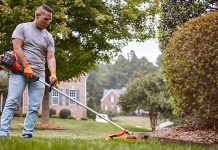This week, in getting know your tractor parts we’ll look at the check and stabiliser chains, power-take-offs, foot brakes, pneumatic (air) brakes and drawbars.
READ: Tractor maintenance: Performing daily checks on your tractor
Know your tractor parts
Check and stabiliser chains
Some makes of tractors are fitted with both check and stabiliser chains, while others will only have one of the two types.
Non-adjustable check chains connected to the differential and lower link arms prevent the three-point lower link arms from fouling the rear tyres.
Adjustable stabiliser chains prevent implement sway while travelling and limit the amount of sideways movement when the implement is working. Generally, when working with an above-ground implement, the stabiliser chains are tightened to prevent any sideways movement of the implement.
Power take-offs
Power-take-offs (PTOs) drive external implements such as balers and rotary hoes. Having six splines and a shaft speed of 540 revolutions per minute at the manufacturer’s recommended engine speed as shown on the tractor’s tachometer, PTOs are normally driven independently of the gearbox.


Disengagement methods differ. One type disengages when you push down on the tractor’s clutch, the second type disengages when you push down on the clutch through to the second stage, (as described under “clutch” in the last issue), and the third is an independent PTO that’s engaged or disengaged by a lever.
For safety reasons, it’s important that the PTO safety cover is always in place and that the cap is screwed in tightly when the shaft isn’t in use.
Foot Brakes
On older tractors, the foot brake is usually activated mechanically, while most modern tractor’s brakes are hydraulically activated and can be coupled to trailer brakes so they act together.
There are two pedals – one for each of the two rear wheels – to help the tractor turn tightly at slow speeds in a small space, such as a narrow headland. These pedals can be latched together to form a master pedal for normal braking, such as when travelling on-road and when pulling a trailer.
Pneumatic (Air) Brakes
Older tractors used with trailers may be fitted with pneumatic (air) brakes. These brakes are activated by air pressure. This pressure is created by a compressor that’s driven by a fan-belt coupled to a pulley, which is fitted to the front of the engine’s crankshaft. This air is stored in a reservoir (tank). You can apply the trailer brakes in two ways.
You can activate a pressure-control valve lever, which applies only the trailer brakes, or you can do it through a valve coupled to the tractor’s foot brakes to ensure that the trailer’s brakes are applied just before the tractor’s to prevent jack-knifing. When starting the tractor’s engine, ensure that the air in the reservoir has reached operating pressure (normally 800kPa) before driving off, and that the twin air lines are correctly coupled.
Drawbars
Standard drawbars are swinging or fixed. The swinging drawbar is either free to swing from side-to-side to a limited degree for use with trailed implements, or it’s fixed in an offset or central position such as when pulling a trailer. An optional hitch is the automatic pickup type with swivelling hook (to prevent an overturning trailer from pulling the tractor over with it). This hitch is used mainly in hauling in the sugarcane and timber industries.
Acknowledgements
This series is based on a tractor parts and implement operating and maintenance training course for small-scale farmers, operators and contractors. The course was originally commissioned by, and developed for, the SA Cane Growers’ Association by Peter Hittersay, who later revised it for the Limpopo agriculture department’s Limpopo Agribusiness Development Academy. Peter thanks both parties for their permission to reproduce the course material in Farmer’s Weekly.
Contact Peter Hittersay on 074 037 9060.













